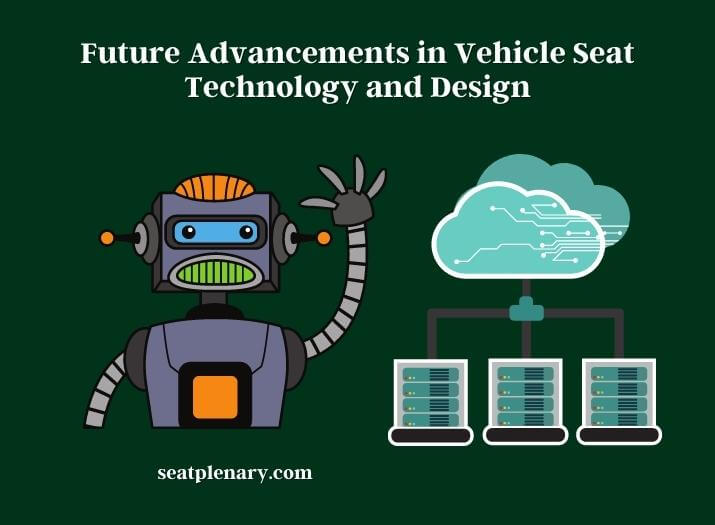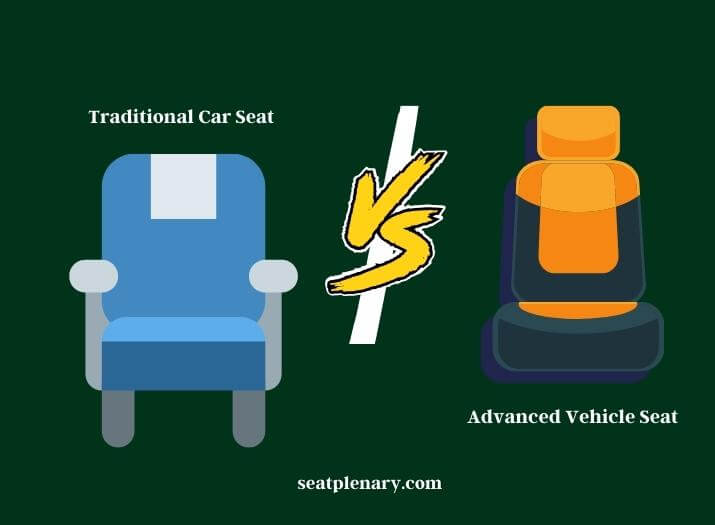The automobile industry is constantly evolving, and it is no secret that innovation and technology play a significant role in its transformation. Vehicles have become more advanced and sophisticated in recent years, incorporating advanced safety features, autonomous capabilities, and improved fuel efficiency.

One aspect of the vehicle that often goes unnoticed is the seats. The importance of vehicle seats in terms of safety, comfort, and style cannot be overstated. As people spend more and more time in their cars, the need for constant innovation and improvement in seat technology and design is becoming increasingly apparent.
Advancements in Technology
Vehicle seat technology has come a long way since the introduction of the first car seat. Today, new and innovative seat technologies are being developed to make driving more comfortable, safer, and more enjoyable for passengers.
Introduction of Smart Seats
These seats will be able to monitor the passenger’s posture, and body temperature, and adjust accordingly, providing optimal comfort and support. The seats can also adjust to different driving modes, such as sport or comfort mode, to provide the passenger with the best driving experience.
Biometric Sensors
Another exciting feature of the future vehicle seat technology is biometric sensors. These sensors will allow seats to detect vital signs such as heart rate, respiration rate, and more, providing real-time health monitoring for passengers. This feature is particularly beneficial for people with medical conditions, allowing them to monitor their health while driving.
Self-Cleaning Seat
Self-cleaning seats are also on the horizon, using ultraviolet light technology to sanitize and clean the seats after use. This technology will be particularly useful in shared mobility services such as ride-hailing, car-sharing, and car rental, where many people use the same vehicle. This will provide passengers with a more hygienic and cleaner environment to sit in, enhancing their overall travel experience.
Inflatable Seat Belts
Inflatable seat belts are another exciting feature of future vehicle seat technology. The seat belts will inflate during a collision, providing more protection to passengers and reducing the risk of injury. This technology will be particularly useful in reducing the impact of head and chest injuries during a crash.
These innovative technologies will revolutionize the automobile industry, enhancing the driving experience for everyone on the road.
Advancements in Design
Along with advancements in technology, the design of vehicle seats is also evolving to provide passengers with more comfortable and spacious interiors.
Ergonomic Seats
Ergonomic Seats are designed to provide maximum comfort and support, reducing the risk of back pain and other discomforts. The seats are designed to adjust to the passenger’s body shape and size, providing a customized fit for a more comfortable driving experience.
Lightweight Seats
Another exciting feature of the future vehicle seat design is lightweight seats. These seats are made from lightweight materials such as aluminum and carbon fiber. Lightweight seats will improve fuel efficiency, reduce the vehicle’s overall weight, and provide more space for passengers and cargo.
This feature will be particularly useful in electric vehicles, where weight reduction is critical to increasing the vehicle’s range.
Modular Seats
Modular seats are another innovative design feature that allows seats to be easily adjusted or removed, providing more space or accommodating different seating configurations. This feature will be particularly useful in shared mobility services, where different seating configurations may be required for different passenger needs.
Sustainable Seats
sustainable seats made from environmentally friendly materials such as recycled plastics and natural fibers will play a significant role in reducing the carbon footprint of the automotive industry.
These seats are designed to be eco-friendly, reducing the amount of waste produced during the manufacturing process and ensuring that the seats are recyclable at the end of their life cycle.
The Difference Between a Traditional Car Seat and an Advanced Vehicle Seat
The difference between a traditional car seat and an advanced vehicle seat is quite significant.

Traditional car seats are usually designed with basic materials such as cloth or leather and offer minimal features such as manually adjustable headrests and lumbar support. These seats are generally designed to be comfortable and functional but lack the advanced technology and features found in advanced vehicle seats.
Advanced vehicle seats, on the other hand, are designed with advanced materials such as memory foam and offer a wide range of features and functions to enhance the passenger’s comfort, safety, and overall driving experience.
These seats are typically designed to provide maximum support and reduce fatigue during long journeys. Some of the features found in advanced vehicle seats include heating and cooling options, adjustable bolstering, massage functions, and lumbar support. Seat heating and cooling features offer several benefits that can enhance your driving experience.
Another significant difference between traditional car seats and advanced vehicle seats is the level of customization available. Advanced vehicle seats are designed to be highly customizable, allowing passengers to adjust the seat to their specific needs and preferences. Some advanced vehicle seats offer adjustable air chambers that adapt to the shape of the passenger’s body, providing a custom fit that maximizes comfort and reduces pressure points.
Advanced vehicle seats offer a significant improvement over traditional car seats in terms of comfort, safety, and overall driving experience. While they may be more expensive, the benefits of advanced vehicle seats are well worth the investment for those who spend a significant amount of time behind the wheel.
Challenges and Considerations
While advancements in technology and design bring exciting new possibilities for vehicle seats, several challenges, and considerations must be taken into account.
Cost – One of the significant challenges facing the development of advanced seat technologies is cost. These innovative technologies come with a significant price tag, making it difficult to integrate them into vehicles without increasing the cost of the vehicle. Manufacturers must find ways to reduce the cost of these technologies while still maintaining their quality and safety.
Vehicle Weight and Energy Consumption – Advanced seat technologies such as smart seats and biometric sensors require additional power and wiring, increasing the vehicle’s weight and energy consumption. Manufacturers must find ways to reduce the energy consumption of these technologies while maintaining their functionality.
Comfort and Safety – The comfort and safety of passengers should always be a top priority. Manufacturers must ensure that the new seat designs and technologies do not compromise passenger safety or comfort. Proper testing and validation must be done to ensure that these new technologies and designs are safe and reliable.
Benefits of Advancements in Vehicle Seat Technology and Design
Advanced vehicle seat technology and design offer numerous benefits that can improve the overall driving experience and make driving more comfortable and safe. Here are some of the main advantages:
Enhanced Comfort
Advanced vehicle seat technology can provide more ergonomic support to the driver and passengers, which can help reduce fatigue and discomfort during long journeys. Seats can be designed to fit the individual needs of drivers and passengers, and materials can be chosen for comfort, breathability, and durability.
Improved Safety
Vehicle seat technology can improve safety by providing better protection to occupants in the event of a crash. Seats can be designed to absorb and distribute impact forces, reducing the risk of injury. Advanced seat belts, airbags, and other safety features can also be integrated into the seat design.
Customizable Features
Advanced vehicle seat technology allows for customization options, such as adjustable lumbar support, heating and cooling systems, and massaging capabilities. These features can provide personalized comfort to the driver and passengers, creating a more enjoyable driving experience.
Increased Space Efficiency
With advanced seat technology, manufacturers can design seats that take up less space, providing more room for passengers and cargo. This can also improve the fuel efficiency of the vehicle, as less weight and space are required for the seats.
Environmental Benefits
Advanced seat technology can also be environmentally friendly, with seats made from eco-friendly materials that can be recycled at the end of their lifespan. More efficient seat designs can also reduce the weight of the vehicle, improving fuel efficiency and reducing emissions.
Frequently Asked Questions
What Are Some of the Latest Trends in Advanced Vehicle Seat Design?
The latest trends in advanced vehicle seat design include the use of lightweight and eco-friendly materials, the integration of smart technologies such as biometric sensors and artificial intelligence, and the incorporation of adjustable air chambers that adapt to the shape of the passenger’s body.
How Do Self-Cleaning Seats Fit into the Future Advancements in Vehicle Seat Technology and Design?
How will self-cleaning seats technology impact future advancements in vehicle seat technology and design? As we move towards a more convenient and efficient driving experience, self-cleaning seats emerge as a valuable innovation. These seats utilize advanced materials and mechanisms to repel dirt, stains, and odors, reducing the need for rigorous cleaning and maintenance.
By integrating self-cleaning technology, car manufacturers can enhance passenger comfort and hygiene, while also simplifying the upkeep of vehicle interiors. This advancement aligns with our goal of creating cleaner and smarter transportation solutions.
How Will Future Advancements in Vehicle Seat Technology Impact Vehicle Design and Styling?
As future advancements in vehicle seat technology continue to evolve, the impact on vehicle design and styling will be significant. The integration of advanced vehicle seats in design will allow for more creative and ergonomic vehicle interiors, leading to innovative and sleeker vehicle designs that prioritize both comfort and style.
How Will Future Advancements in Vehicle Seat Technology Impact the History of Vehicle Seat Development?
Future advancements in vehicle seat technology will undoubtedly revolutionize the vehicle seat design history. With innovations like smart fabrics, adjustable support systems, and sustainable materials, the future of vehicle seating will prioritize comfort, safety, and environmental impact. These advancements will forever change the way we view and experience vehicle seat design history.
Can Advanced Vehicle Seats Improve Safety While Driving?
Yes, advanced vehicle seats can improve safety while driving. Seats with advanced safety features such as integrated airbags, side-impact protection, and seatbelt pre-tensioners can reduce the risk of injury in the event of an accident. Additionally, seats designed to reduce fatigue can help prevent driver drowsiness, which is a common cause of accidents.
Are Advanced Vehicle Seats Expensive?
Advanced vehicle seats are typically more expensive than traditional car seats due to the advanced materials and features they offer. However, the cost can vary depending on the level of technology and features included. Some advanced vehicle seats may also help save on medical costs and improve the overall quality of life for people with chronic back pain or other health issues.
Wrap-Up
The future of vehicle seat technology and design is exciting, with many innovative features on the horizon. Advancements in technology are transforming the way we think about vehicle seats, improving passenger comfort and safety, while also enhancing the overall driving experience.
From smart seats that adjust to the passenger’s body to biometric sensors that monitor passenger health, the new technology offers a range of exciting possibilities. Along with the advancements in technology, vehicle seat design is also evolving to provide passengers with more spacious, comfortable, and eco-friendly interiors.
As with any new technology, there are challenges and considerations that need to be addressed. These include the cost, weight, energy consumption, safety, and environmental impact of these new technologies and designs.
Manufacturers must carefully consider these challenges and take proactive steps to ensure that the new technologies and designs are sustainable, safe, and affordable for all. With proper planning and consideration, the future of vehicle seat technology and design is bright, providing a safer, more comfortable, and more sustainable driving experience for everyone on the road.
